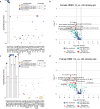Resolving multi-image spatial lipidomic responses to inhaled toxicants by machine learning
- PMID: 40140638
- PMCID: PMC11947182
- DOI: 10.1038/s41467-025-58135-4
Resolving multi-image spatial lipidomic responses to inhaled toxicants by machine learning
Abstract
Regional responses to inhaled toxicants are essential to understand the pathogenesis of lung disease under exposure to air pollution. We evaluate the effect of combined allergen sensitization and ozone exposure on eliciting spatial differences in lipid distribution in the mouse lung that may contribute to ozone-induced exacerbations in asthma. We demonstrate the ability to normalize and segment high resolution mass spectrometry imaging data by applying established machine learning algorithms. Interestingly, our segmented regions overlap with histologically validated lung regions, enabling regional analysis across biological replicates. Our data reveal differences in the abundance of spatially distinct lipids, support the potential role of lipid saturation in healthy lung function, and highlight sex differences in regional lung lipid distribution following ozone exposure. Our study provides a framework for future mass spectrometry imaging experiments capable of relative quantification across biological replicates and expansion to multiple sample types, including human tissue.
© 2025. The Author(s).
Conflict of interest statement
Competing interests: The authors declare no competing interests.
Figures






Update of
-
Resolving multi-image spatial lipidomic responses to inhaled toxicants by machine learning.bioRxiv [Preprint]. 2024 Jul 10:2024.07.05.602264. doi: 10.1101/2024.07.05.602264. bioRxiv. 2024. Update in: Nat Commun. 2025 Mar 26;16(1):2954. doi: 10.1038/s41467-025-58135-4. PMID: 39026864 Free PMC article. Updated. Preprint.
References
-
- ALA. State of the air report 2022. Chicago, IL: American Lung Association; 2022.
-
- Plopper, C. et al. Relationship of inhaled ozone concentration to acute tracheobronchial epithelial injury, site-specific ozone dose, and glutathione depletion in rhesus monkeys. Am. J. Respir. Cell Mol. Biol.19, 387–399 (1998). - PubMed

